Root 2 is irrational - proof by prime factors
Categories: number theory

There are several proofs that the square root of 2 is irrational. The earliest dates back to Euclid, around 300 BC. In this article, we will look at an alternative proof, based on prime factors.
This proof has several advantages:
- It is simpler.
- It can be easily applied to other numbers.
- It provides a good explanation of why perfect squares are a special case.
- It can be easily applied to higher powers.
- It can also be used to prove the stronger statement that any integer root of an integer value is either an integer or irrational.
Proof by contradiction
We will use a proof by contradiction. We will start by assuming that the square root of 2 is rational, and prove that this leads to a contradiction, so root 2 cannot be rational.
If root 2 was rational, then by definition, there must be some positive integers a and b for which:
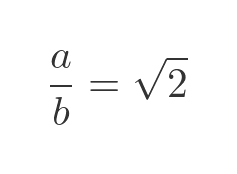
Squaring both sides gives:
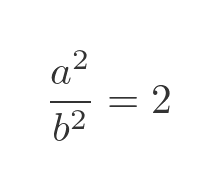
So for root 2 to be rational, there must be positive integer values a and b such that:
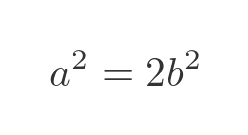
If we can prove that no such integer values can exist, then we have proved that the root of 2 cannot be rational and therefore must be irrational.
Prime factors
According to the fundamental theorem of arithmetic, every positive integer greater than 1 can be uniquely represented as a product of prime numbers. For example:
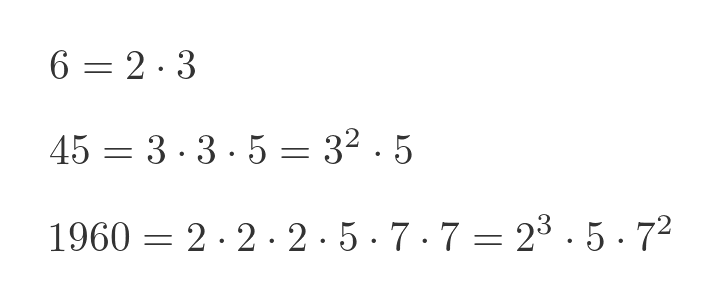
The theorem tells us two things. The first is that any positive number greater than 1 can be expressed as a product of one or more prime numbers. The second thing it tells us is that, for any particular number, there is only one way to do it. For instance, 45 can be expressed as 3 squared times 5, and there is no other way to express 45 as a product of primes.
The reason this only applies to numbers greater than 1 is that 1 itself is not a prime number.
For many numbers, the same prime number might appear as a factor more than once. For example, 1960 has three factors of 2, and two factors of 7. These can either be written as repeated multiplications or as powers (both are shown in the examples above). For this article, expressing them as powers is more useful, so we will use that notation from now on.
The number of times each prime appears in the factorisation is called the order of the factor. So in the example of 1960, we would say that 2 is a prime factor of order 3, 5 is a prime factor of order 1, and 7 is a prime factor of order 2. We could also say that 11 is a prime factor of order 0 because it doesn't appear in the factorisation at all.
In general, we can represent any integer n, greater than 1, as the product of a set of prime numbers p each raised to a positive integer power r:
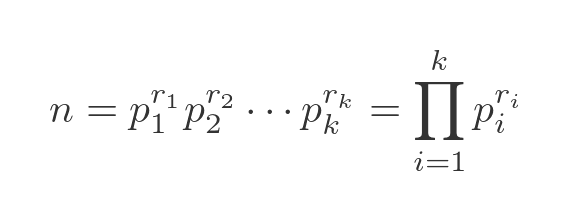
Squaring a number using prime factors
The square of an integer n can be found by multiplying n by itself:

We can rearrange the product, by grouping each pair of factors for each prime:

Now we know from basic arithmetic that when we multiply powers of the same base, we just add the exponents:
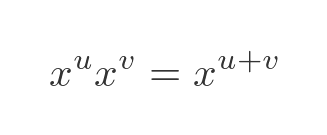
In our case, the exponents are equal, so we get this:
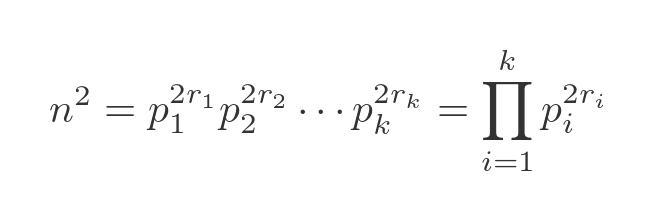
So to calculate n squared, we take the prime factors of n and double each of the powers. But the really important thing we get from this is that for a perfect square, the exponent of every prime factor is an even number. For example:
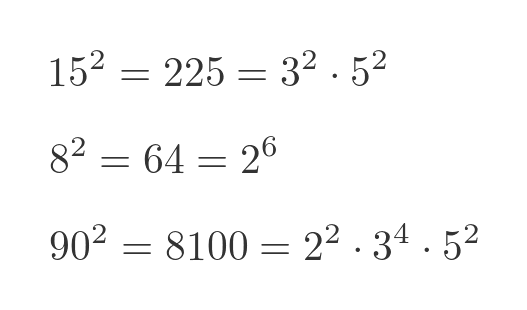
Proof that the square root of 2 is irrational
We previously discovered that root 2 cannot be rational unless there are some positive integer values a and b such that:

We also know from the fundamental theorem of arithmetic that for two positive integers x and y to be equal, they must have identical prime factors.
In particular, if x has 2 as a factor of order m (that is, if 2 appears m times in the factorisation) then y must also have 2 as a factor of order m:

Of course, all the other prime factors must also have identical orders. But we will only look at the powers of 2 because if we can prove they are different, then that is sufficient to prove that x and y are not equal.
Now recall that, for a perfect square, every prime factor must have an even order. This means that for a squared, the order of prime factor 2 must be even:
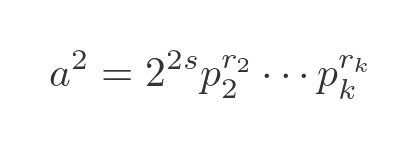
The order can be zero, of course, meaning that 2 isn't a prime factor at all - zero is an even number. For b squared, the order of prime factor 2 must be also even:
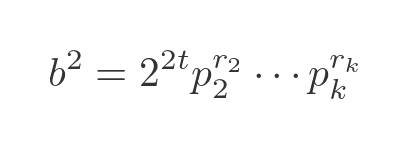
But what about 2 times b squared? Since we have multiplied by 2, the order of prime factor 2 must be odd:

So now let's compare the a and b terms:

2s must be even, and 2t + 1 must be odd, so those two values can never be equal. This means that a squared can never equal 2 times b squared for any positive integer values of a and b.
This proves that the square root of 2 cannot be rational and, therefore must be irrational.
Proof for square roots of other numbers
It is quite easy to see how this can be applied to other numbers. For example, is the square root of 3 rational? If we follow the same logic as before, it requires us to find integers a and b such that:
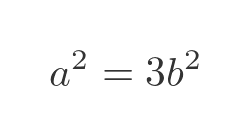
This time, we can observe that a squared must have an even power of 3, whereas 3 times b squared must contain an odd power of 3, so again the square root of 3 cannot be rational:

Is the square root of 4 rational? Of course, we know that it is! But it is useful to see how this plays out using the previous logic. This time we need to find integer solutions to the equation:
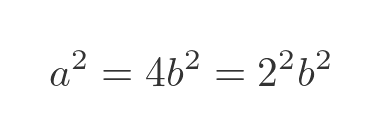
Notice that we have expanded the value 4 into its prime factors, that is 2 squared. We didn't need to do that previously because those values (2 and 3) were primes anyway.
In this example, again, we are concerned with powers of 2. As before, we observe that a squared must contain an even power of 2, and b squared must contain an even power of 2. But is this case 4 times b squared must contain an even power of 2:
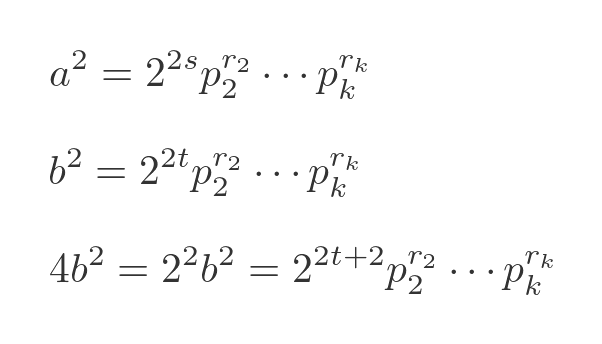
So this time, both sides of the original equation contain an even power of 2, so a solution might be possible. And in fact, it is solved by a = 2, b = 1, meaning that the square root of 4 is 2.
In general (not proven here), to find out if the square root of integer x is rational, first find its prime factors. If all the prime factors have an order that is an even number, then x is a perfect square and so has a rational result (actually an integer result, as we will see later). If any of the prime factors have an odd order, the square root is irrational.
Proof for cube roots and higher
Is the cube root of 2 rational? We won't look at this in great detail, but we will sketch out the basic idea as to why it is not. This follows very similar lines to the proof for the square root.
This time we need to find a, b such that:
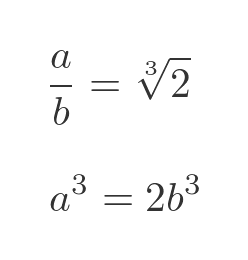
The value of a cubed must contain a power of 2 that is a multiple of 3 (which, again, can be 0). Similarly b cubed must contain a power of 2 that is a multiple of 3. And 3 times b cubed must contain a power of 2 that is a multiple of 3 plus 1:
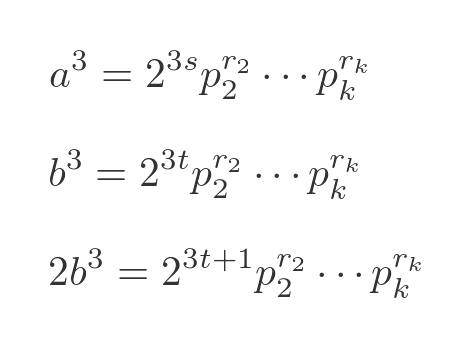
So a cubed cannot have the same prime factors as 3 times b cubed, so they cannot be equal, therefore the cube root of 2 must be irrational.
The root of an integer value is either an integer or irrational
We know that the square root of a positive integer is sometimes an integer, and sometimes not. When the result is not an integer, we have seen that it might be an irrational number.
We can go further than that, and say that the result will always be either an integer or an irrational number. That is to say, it cannot possibly be a rational fraction.
We can prove this for the general case:
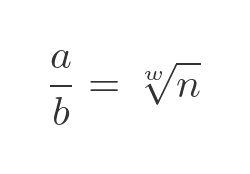
Let's assume a/b has been reduced to its simplest form, so that a and b have no common factors other than 1. Then we raise both sides to the power W:
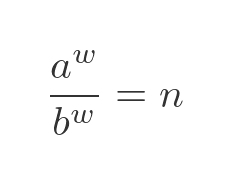
Now since n is a positive integer, and since a and b have no common factors, then b must equal 1, otherwise n would not be an integer. Therefore, the positive integer w root of a positive integer n cannot be a rational fraction.
So it can only be either an integer or an irrational number.
Related articles
Join the GraphicMaths Newsletter
Sign up using this form to receive an email when new content is added to the graphpicmaths or pythoninformer websites:

Popular tags
adder adjacency matrix alu and gate angle answers area argand diagram binary maths cardioid cartesian equation chain rule chord circle cofactor combinations complex modulus complex numbers complex polygon complex power complex root cosh cosine cosine rule countable cpu cube decagon demorgans law derivative determinant diagonal directrix dodecagon e eigenvalue eigenvector ellipse equilateral triangle erf function euclid euler eulers formula eulers identity exercises exponent exponential exterior angle first principles flip-flop focus gabriels horn galileo gamma function gaussian distribution gradient graph hendecagon heptagon heron hexagon hilbert horizontal hyperbola hyperbolic function hyperbolic functions infinity integration integration by parts integration by substitution interior angle inverse function inverse hyperbolic function inverse matrix irrational irrational number irregular polygon isomorphic graph isosceles trapezium isosceles triangle kite koch curve l system lhopitals rule limit line integral locus logarithm maclaurin series major axis matrix matrix algebra mean minor axis n choose r nand gate net newton raphson method nonagon nor gate normal normal distribution not gate octagon or gate parabola parallelogram parametric equation pentagon perimeter permutation matrix permutations pi pi function polar coordinates polynomial power probability probability distribution product rule proof pythagoras proof quadrilateral questions quotient rule radians radius rectangle regular polygon rhombus root sech segment set set-reset flip-flop simpsons rule sine sine rule sinh slope sloping lines solving equations solving triangles square square root squeeze theorem standard curves standard deviation star polygon statistics straight line graphs surface of revolution symmetry tangent tanh transformation transformations translation trapezium triangle turtle graphics uncountable variance vertical volume volume of revolution xnor gate xor gate
